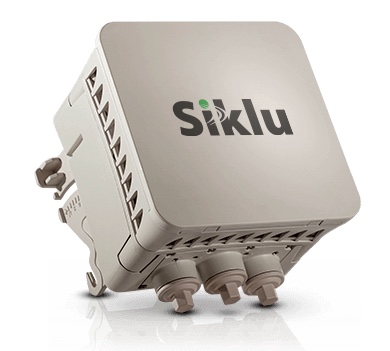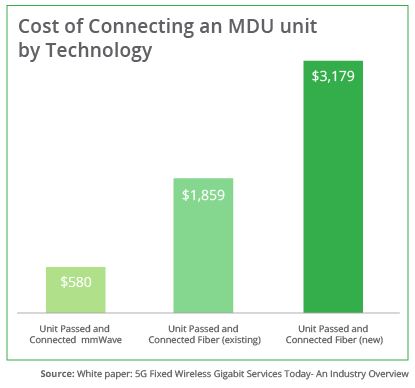
Thought leader Adlane Fellah, CEO of Maravedis, one of telecom industry?s principal analyst firms, provides the latest overview and trends of the wireless industry and describes the benefits of Fixed Wireless Access (FWA) as a part of Hybrid Fiber-Wireless (HFW) topology.
There are close to 126 million households in the US, out of which 106 million have some form of broadband. FCC reports have found that about three-quarters of the country?s developed census blocks lack any high-speed broadband choice.
Moreover, only a very small fraction of those households has access to 21th century broadband above 100 Mbps which is required to empower users with the emerging applications in the connected home including 4K and 8K televisions, virtual reality, IoT, and the proliferation of user devices. In other words, homes are rapidly becoming high density wireless environments which require way beyond 25 Mbps connectivity.
The next generation of mobile telecommunications systems, IMT-2020 (commonly known as 5G), has yet to be standardised. However, much progress has already been made in developing 5G specifications. In addition to mobile broadband, 5G will also enable fixed wireless broadband, delivering gigabit throughput to a variety of end users without the need for costly fiber-to-the-premises (FTTP) installations.
The Case for Fixed Wireless Access (FWA)
In a recently published white paper, Maravedis discusses the advantages of using millimeter wave (mmWave) technologies, to deploy fiber-like, Fixed Wireless Access (FWA). 5G FWA can provide gigabit broadband service using both licensed and unlicensed mmWave spectrum, making it an ideal option for both small and large internet service providers (ISPs).
Furthermore, since the cost and speed of 5G FWA infrastructure deployment easily beats the cost and time required to extend fiber-optic cables straight to the premises, (FTTP, or fiber-to-the-home, FTTH), 5G FWA allows fiber networks to easily be deployed and scaled without compromising broadband speed or reliability.
For example, single family homes in a suburban area could be serviced with a point-to-multipoint (PtMP) topology by using existing 60 GHz V-Band products. Similarly, multiple dwelling units (MDUs) in both urban and suburban environments could be serviced with a point-to-point (PtP) topology, using the same currently available technology. Thus, with its fiber-like capacity, ease of deployment, and currently available solutions, 5G fixed wireless is great option for the so-called ?last mile? of fiber networks.
The Case for Unlicensed FWA
The use of mmWave spectrum offers service providers an excellent opportunity to stay competitive considering ineffective, monopolistic broadband services in the U.S. In 2016, the U.S. Federal Communications Commission (FCC) released a report that concluded that ?advanced telecommunications capability is not being deployed to all Americans in a reasonable and timely fashion.?
A large contributing factor to this problem is the domination of spectrum by large ISPs like Verizon and AT&T. While these companies have managed to purchase a significant portion of licensed mmWave spectrum, such as the 28 GHz band, the FCC has allocated 14 GHz of contiguous unlicensed spectrum in the 60 GHz V-Band. This gives small ISPs the chance to utilize mmWave technology without the large cost needed to purchase licensed spectrum.
Using unlicensed or lightly-licensed mmWave frequencies, such as the 60 GHz V-Band or 70/80 GHz E-Band, is therefore a cost-effective choice for deploying fiber-like 5G FWA. Commercial mmWave radios are currently available for this purpose, capable of operating in a point-to-point (PtP) or point-to-multipoint (PtMP) topology to deliver gigabit broadband to businesses, Multiple Dwelling Units (MDUs), and single-family homes.
In addition to the cost, time, and scalability advantages of 5G FWA (as opposed to FTTH), a multitude of 5G trials and deployments have validated the technology for 5G FWA. Even though the final 5G standard isn?t expected until 2020, many service providers around the world plan to roll out pre-standard 5G networks as early as 2017. As the technology has been demonstrated and offers several advantages, including gigabit throughput and inexpensive infrastructure, 5G FWA solutions present an appealing option for service providers looking to extend their coverage and compete with larger ISPs.
Best of Both Worlds: The Hybrid Fiber-Wireless (HFW) option
As demonstrated in the business cases presented in the white paper, mmWave results as the most cost-effective solution in both single units and multi dwelling units? deployment scenarios. But carriers don?t have to choose between mmWave and fiber. They need both and these technologies complement each other to provide the most cost-effective solution under the HFW model.
The Hybrid Fiber-Wireless (HFW) is a disruptive model for providing GTTH built on proven technology. This model adds high frequency wireless radios to a fiber network, drastically reducing deployment costs, time to install and with the potential to provide multiple gigabits directly to the consumer. Simply put: using HFW, providers can deploy a gigabit first and far cheaper than competitors. Using an HFW connectivity model will finally open access to 21th century broadband to millions of US households.
Furthermore, since the cost and speed of 5G FWA infrastructure deployment easily beats the cost and time required to extend fiber-optic cables straight to the premises, (FTTP, or fiber-to-the-home, FTTH), 5G FWA allows fiber networks to easily be deployed and scaled without compromising broadband speed or reliability.
For example, single family homes in a suburban area could be serviced with a point-to-multipoint (PtMP) topology by using existing 60 GHz V-Band products. Similarly, multiple dwelling units (MDUs) in both urban and suburban environments could be serviced with a point-to-point (PtP) topology, using the same currently available technology. Thus, with its fiber-like capacity, ease of deployment, and currently available solutions, 5G fixed wireless is a great option for the so-called ?last mile? of fiber networks.
About the Author
Adlane Fellah is the CEO of Maravedis, a leading wireless analyst firm, and Wi-Fi 360, the only content marketing agency dedicated to the Wi-Fi industry. Mr. Fellah authored various landmark reports on Wi-Fi, LTE, 4G and technology trends in various industries including retail, restaurant and hospitality. He is regularly asked to speak at leading wireless and marketing events and to contribute to various influential portals and magazines such as RCR Wireless, 4G 360, Rethink Wireless, The Mobile Network, Telecom Reseller, just to name a few. He is a Certified Wireless Network Administrator (CWNA) and Certified Wireless Technology Specialist (CWTS).


